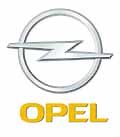

New Edition
of Successful Model
New engines:
More power with lower consumption
New styling:
Accentuated dynamic look
New equipment:
More options for personal customization
New chassis
electronics: Trailer Stability Assist even safer

Neuauflage des Erfolgsmodells
Neue Motoren: Mehr Kraft bei weniger Verbrauch
Neue Optik: Akzentuierung des dynamischen
Auftritts
Neue Ausstattungen: Mehr Spielraum für
individuelle Wünsche
Neue Fahrwerk-Elektronik:
Anhänger-Stabilitätsprogramm noch sicherer |
Opel Astra 2007
Rüsselsheim.
With new, more economical engines, a refined look, enhanced technology and
an expanded equipment range, the new edition of the Opel Astra is available
at dealerships from February 2007 at a practically unchanged, affordable
price starting from 16,160 euros.
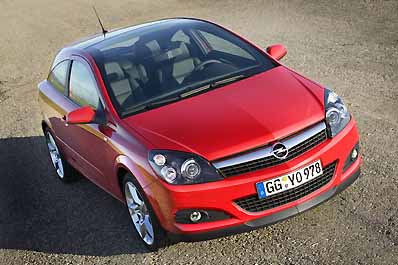 The whole Astra family benefits from the model update,
from the five-door and station wagon variants to the sporty three-door GTC
and dynamic, elegant TwinTop cabrio-coupé. The new Opel Astra made
its world premiere at the Bologna Motor Show in December. With more than
1.2 million units sold since its market launch in March 2004, the
third-generation Astra plays a leading role in the fiercely competitive compact
segment and in European sales statistics. The bestseller will now be available
with a range of eleven different engine versions, producing between 90 and
240 hp. The whole Astra family benefits from the model update,
from the five-door and station wagon variants to the sporty three-door GTC
and dynamic, elegant TwinTop cabrio-coupé. The new Opel Astra made
its world premiere at the Bologna Motor Show in December. With more than
1.2 million units sold since its market launch in March 2004, the
third-generation Astra plays a leading role in the fiercely competitive compact
segment and in European sales statistics. The bestseller will now be available
with a range of eleven different engine versions, producing between 90 and
240 hp.
|
New engine
range
Efficiency increase
at the highest level
With two additional 1.6-liter gasoline engines and two 1.7 CDTI common-rail
turbo-diesels (available from spring 2007), the Astra engine range offers
additional highly efficient propulsion units that are already technologically
capable of meeting future emissions standards.
1.6 ECOTEC: Cam-phase meets
drivers’ needs
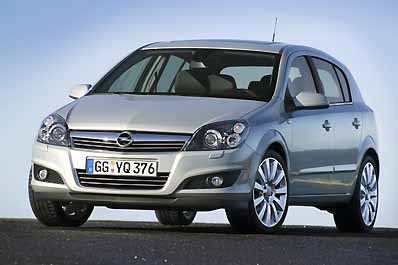 The new 1.6 ECOTEC with 85 kW/115 hp
offers improved elasticity and smoothness compared to the 1.6-liter engine
with 77 kW/105 hp (10 percent more output as well as around three percent
less consumption). The improved torque curve is especially noticeable during
driving, peaking at 155 Nm and available across a wide rpm range. This translates
into powerful propulsion power even at low rpm. With this new engine, the
Astra GTC accelerates from zero to 100 km/h in 11.6 seconds and reaches a
top speed of 193 km/h. The advantages of the new 114 kilogram four-cylinder,
four-valve engine, which has a power-to-weight ratio of 0.99 kg/hp, are based
primarily on “Cam-Phase” technology. This involves continuous variable
valve timings via intake and exhaust camshafts that are adjustable to the
driving situation. Both camshafts are controlled seamlessly and independently
from one other by engine management in real time, with two compact, vane-type
hydraulic adjusters controlling the timing. This allows the intake and exhaust
valve timings, and therefore also the engine characteristic, to be more
spontaneous and better match each power and performance requirement, which
the driver “defines” via the accelerator pedal and gear change.
The simple and yet so effective TWINPORT concept, which was introduced by
Opel into all gasoline engines with up to 1.6 liters displacement in 2003,
was furthered developed with the 115 hp 1.6-liter engine. Its cylinder head
has two separate intake ports per cylinder, just like the 1.6 TWINPORT. While
until now manifold flaps were required to ensure stable and consistent
combustion, the 1.6 ECOTEC functions without these flaps in its new, two-stage,
variable length, plastic intake pipe. This is thanks to the optimized inlet
port alignment in combination with cam-phase. The dethrottled gas exchange
improves fuel efficiency: the 115 hp GTC and five-door Astra require only
an average of 6.3 liters of super unleaded gasoline per 100 kilometers when
fitted with the five-speed Easytronic transmission. The high rates of exhaust
gas recirculation, a pre-requisite for reduced emissions, are typical of
TWINPORT engines. Over one quarter of the cylinder charge during partial
load comes from previously combusted fuel. Instead of the additional external
line, an even more efficient internal recirculation system is in use. This
enables the hot and combustible exhaust gases to be directly recycled within
the cylinder head. For the first time in this engine class, Opel also uses
laser-structured cylinder barrels in the 1.6 ECOTEC. The exactly defined,
minute recesses are etched during a special production stage, and act as
a micro pressure chamber system. This leads to minimized piston friction
and has a positive effect on abrasion, fuel and oil consumption. Other
technological highlights of the high-tech engine include the map-controlled
thermostat and new, low-drawn exhaust manifold with integrated catalytic
converter. The new 1.6 ECOTEC with 85 kW/115 hp
offers improved elasticity and smoothness compared to the 1.6-liter engine
with 77 kW/105 hp (10 percent more output as well as around three percent
less consumption). The improved torque curve is especially noticeable during
driving, peaking at 155 Nm and available across a wide rpm range. This translates
into powerful propulsion power even at low rpm. With this new engine, the
Astra GTC accelerates from zero to 100 km/h in 11.6 seconds and reaches a
top speed of 193 km/h. The advantages of the new 114 kilogram four-cylinder,
four-valve engine, which has a power-to-weight ratio of 0.99 kg/hp, are based
primarily on “Cam-Phase” technology. This involves continuous variable
valve timings via intake and exhaust camshafts that are adjustable to the
driving situation. Both camshafts are controlled seamlessly and independently
from one other by engine management in real time, with two compact, vane-type
hydraulic adjusters controlling the timing. This allows the intake and exhaust
valve timings, and therefore also the engine characteristic, to be more
spontaneous and better match each power and performance requirement, which
the driver “defines” via the accelerator pedal and gear change.
The simple and yet so effective TWINPORT concept, which was introduced by
Opel into all gasoline engines with up to 1.6 liters displacement in 2003,
was furthered developed with the 115 hp 1.6-liter engine. Its cylinder head
has two separate intake ports per cylinder, just like the 1.6 TWINPORT. While
until now manifold flaps were required to ensure stable and consistent
combustion, the 1.6 ECOTEC functions without these flaps in its new, two-stage,
variable length, plastic intake pipe. This is thanks to the optimized inlet
port alignment in combination with cam-phase. The dethrottled gas exchange
improves fuel efficiency: the 115 hp GTC and five-door Astra require only
an average of 6.3 liters of super unleaded gasoline per 100 kilometers when
fitted with the five-speed Easytronic transmission. The high rates of exhaust
gas recirculation, a pre-requisite for reduced emissions, are typical of
TWINPORT engines. Over one quarter of the cylinder charge during partial
load comes from previously combusted fuel. Instead of the additional external
line, an even more efficient internal recirculation system is in use. This
enables the hot and combustible exhaust gases to be directly recycled within
the cylinder head. For the first time in this engine class, Opel also uses
laser-structured cylinder barrels in the 1.6 ECOTEC. The exactly defined,
minute recesses are etched during a special production stage, and act as
a micro pressure chamber system. This leads to minimized piston friction
and has a positive effect on abrasion, fuel and oil consumption. Other
technological highlights of the high-tech engine include the map-controlled
thermostat and new, low-drawn exhaust manifold with integrated catalytic
converter. |
1.6 Turbo ECOTEC: Light,
compact powerhouse with Overboost
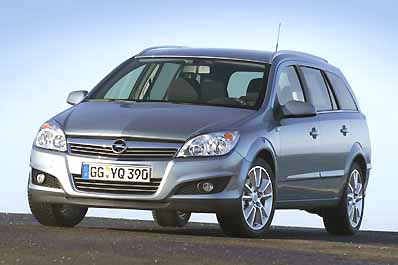 A similarly impressive balancing act
between performance and economy is achieved by the 132 kW/180 hp 1.6 turbo
engine, which replaces the 2.0-liter turbo with 125 kW/170 hp. The lighter
engine, which also offers taxation benefits thanks to its smaller displacement,
consumes an average of only 7.7 liters per 100 kilometers and boasts improved
driving performance (Astra GTC top speed: 223 km/h; zero to 100 km/h in 8.2
seconds). Compared with its predecessor, consumption is reduced by 1.3 liters
for a total consumption reduction of more than 13 percent. At the same time,
the 131 kilogram compact engine - the most powerful series production turbo
unit in this displacement class - produces considerable acceleration. The
Astra GTC reaches 100 km/h from a standing start in 8.2 seconds, and has
a top speed of 223 km/h. In addition to the immediate turbo response, the
pronounced elasticity of the engine with sequential manifold injection is
also noticeable. This enables the GTC to accelerate from 80 to 120 km/h in
fifth gear in just 8.4 seconds. The normal maximum torque of 230 Nm is available
constantly between 1980 and 5500 rpm, and together with the standard six-speed
manual transmission, is an essential precondition for top driving performance.
A special feature of the new engine is the turbocharger’s electronically
controlled Overboost function. This enables a quick boost of torque to up
to 266 Nm. The electronics recognize the need for Overboost by the speed
with which the accelerator pedal is pressed. The additional power is available
for a maximum of five seconds; after that, the control unit seamlessly regulates
the torque back to the normal value of 230 Nm. This function helps the driver
to complete quick and safe overtaking maneuvers. Other construction highlights
of the 1.6 turbo engine, which has an output per liter of 112.3 hp, include
a rapid-response compressor with external water cooling integrated into the
exhaust gas manifold. Its turbine reaches over 200,000 rpm. Other features
include the air-cooled intercooler, exhaust valves that are cooled by sodium
in the shaft, and oil-spray cooling of the flat pistons. There is also the
stronger crankshaft drive, friction-optimized operation of the camshafts,
and the new two-mass flywheel with torsional-vibration damper improves running
smoothness. The preconverter directly behind the turbine outlet supplements
the main underfloor catalytic converter and improves the quick response of
the three-way exhaust emission control. A similarly impressive balancing act
between performance and economy is achieved by the 132 kW/180 hp 1.6 turbo
engine, which replaces the 2.0-liter turbo with 125 kW/170 hp. The lighter
engine, which also offers taxation benefits thanks to its smaller displacement,
consumes an average of only 7.7 liters per 100 kilometers and boasts improved
driving performance (Astra GTC top speed: 223 km/h; zero to 100 km/h in 8.2
seconds). Compared with its predecessor, consumption is reduced by 1.3 liters
for a total consumption reduction of more than 13 percent. At the same time,
the 131 kilogram compact engine - the most powerful series production turbo
unit in this displacement class - produces considerable acceleration. The
Astra GTC reaches 100 km/h from a standing start in 8.2 seconds, and has
a top speed of 223 km/h. In addition to the immediate turbo response, the
pronounced elasticity of the engine with sequential manifold injection is
also noticeable. This enables the GTC to accelerate from 80 to 120 km/h in
fifth gear in just 8.4 seconds. The normal maximum torque of 230 Nm is available
constantly between 1980 and 5500 rpm, and together with the standard six-speed
manual transmission, is an essential precondition for top driving performance.
A special feature of the new engine is the turbocharger’s electronically
controlled Overboost function. This enables a quick boost of torque to up
to 266 Nm. The electronics recognize the need for Overboost by the speed
with which the accelerator pedal is pressed. The additional power is available
for a maximum of five seconds; after that, the control unit seamlessly regulates
the torque back to the normal value of 230 Nm. This function helps the driver
to complete quick and safe overtaking maneuvers. Other construction highlights
of the 1.6 turbo engine, which has an output per liter of 112.3 hp, include
a rapid-response compressor with external water cooling integrated into the
exhaust gas manifold. Its turbine reaches over 200,000 rpm. Other features
include the air-cooled intercooler, exhaust valves that are cooled by sodium
in the shaft, and oil-spray cooling of the flat pistons. There is also the
stronger crankshaft drive, friction-optimized operation of the camshafts,
and the new two-mass flywheel with torsional-vibration damper improves running
smoothness. The preconverter directly behind the turbine outlet supplements
the main underfloor catalytic converter and improves the quick response of
the three-way exhaust emission control. |
Seven gasoline engines
from 1.4-liter fuel-saver to 2.0-liter power turbo
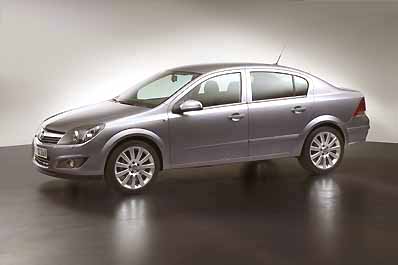 Including the new engines, seven gasoline
units are now available for Astra customers - a range which sets the standard
in this class. Current units include the extremely efficient 1.4 TWINPORT
ECOTEC with 66 kW/90 hp, which like the 1.6-liter version with 105 hp also
features Opel’s efficient TWINPORT fuel-saving technology. Introduced
in November 2005, the 1.8 ECOTEC with 103 kW/140 hp is also very popular
among Astra buyers. In order to optimize consumption and performance, this
high-tech engine also operates with two variable camshafts, just like the
new 115 hp 1.6-liter unit. The Astra’s gasoline engine range also includes
a refined 2.0 turbo unit with 147 kW/200 hp and the top-of-the-line 2.0-liter
turbo with 177 kW/240 hp and 320 Nm of torque, which is reserved exclusively
for the high-performance Astra OPC, pushing the powerful three-door car into
established sports cars territory. The Astra OPC accelerates from zero to
100 km/h within 6.4 seconds and has a top speed of 244 km/h - at an average
consumption rate of just 9.2 liters per 100 kilometers. Depending on the
engine, a five or six-speed manual transmission, a five-speed Easytronic
or a four-speed automatic gearbox is available. Including the new engines, seven gasoline
units are now available for Astra customers - a range which sets the standard
in this class. Current units include the extremely efficient 1.4 TWINPORT
ECOTEC with 66 kW/90 hp, which like the 1.6-liter version with 105 hp also
features Opel’s efficient TWINPORT fuel-saving technology. Introduced
in November 2005, the 1.8 ECOTEC with 103 kW/140 hp is also very popular
among Astra buyers. In order to optimize consumption and performance, this
high-tech engine also operates with two variable camshafts, just like the
new 115 hp 1.6-liter unit. The Astra’s gasoline engine range also includes
a refined 2.0 turbo unit with 147 kW/200 hp and the top-of-the-line 2.0-liter
turbo with 177 kW/240 hp and 320 Nm of torque, which is reserved exclusively
for the high-performance Astra OPC, pushing the powerful three-door car into
established sports cars territory. The Astra OPC accelerates from zero to
100 km/h within 6.4 seconds and has a top speed of 244 km/h - at an average
consumption rate of just 9.2 liters per 100 kilometers. Depending on the
engine, a five or six-speed manual transmission, a five-speed Easytronic
or a four-speed automatic gearbox is available. |
Wide range of diesel engines
expanded
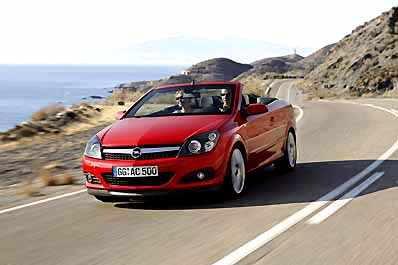 The range of diesel engines for the
new edition Astra is just as rich in variety. It has been expanded with the
1.7 CDTI units with 81 kW/110 hp or 92 kW/125 hp. The two high-tech diesel
engines with six-speed manual transmission as standard and maintenance-free
particulate filter – a standard feature of all Astra diesels –
will replace the 1.9 CDTI with 74 kW/100 hp and the 1.9 CDTI with manual
transmission and 88 kW/120 hp in the course of spring 2007. The 120 hp 1.9
CDTI with six-speed automatic gearbox remains in the range. Just like the
gasoline engines, these boast increased power with lower consumption and
reduced emission levels compared to the predecessor units. Both 1.7 CDTI
engines feature common-rail direct injection and four-valve technology with
swirl control for pronounced refinement, high responsiveness and exemplary
fuel efficiency. For the five-door Astra for example, engineers cite a saving
of between 0.5 and 0.9 liters of diesel per 100 kilometers. The new Astra’s
selection of ultra-modern turbo diesels, from the 1.3 CDTI with 66 kW/90
hp to the 1.9 CDTI with 110 kW/150 hp, is wider than ever and unique in this
class. This is also true of the modern transmission range. Depending on the
diesel engine, the customer has the choice between the sporty manual gearbox,
automated Easytronic manual transmission and comfortable converter gearbox
- all of which are six-speed versions. The range of diesel engines for the
new edition Astra is just as rich in variety. It has been expanded with the
1.7 CDTI units with 81 kW/110 hp or 92 kW/125 hp. The two high-tech diesel
engines with six-speed manual transmission as standard and maintenance-free
particulate filter – a standard feature of all Astra diesels –
will replace the 1.9 CDTI with 74 kW/100 hp and the 1.9 CDTI with manual
transmission and 88 kW/120 hp in the course of spring 2007. The 120 hp 1.9
CDTI with six-speed automatic gearbox remains in the range. Just like the
gasoline engines, these boast increased power with lower consumption and
reduced emission levels compared to the predecessor units. Both 1.7 CDTI
engines feature common-rail direct injection and four-valve technology with
swirl control for pronounced refinement, high responsiveness and exemplary
fuel efficiency. For the five-door Astra for example, engineers cite a saving
of between 0.5 and 0.9 liters of diesel per 100 kilometers. The new Astra’s
selection of ultra-modern turbo diesels, from the 1.3 CDTI with 66 kW/90
hp to the 1.9 CDTI with 110 kW/150 hp, is wider than ever and unique in this
class. This is also true of the modern transmission range. Depending on the
diesel engine, the customer has the choice between the sporty manual gearbox,
automated Easytronic manual transmission and comfortable converter gearbox
- all of which are six-speed versions. |
All Astra engines in
overview
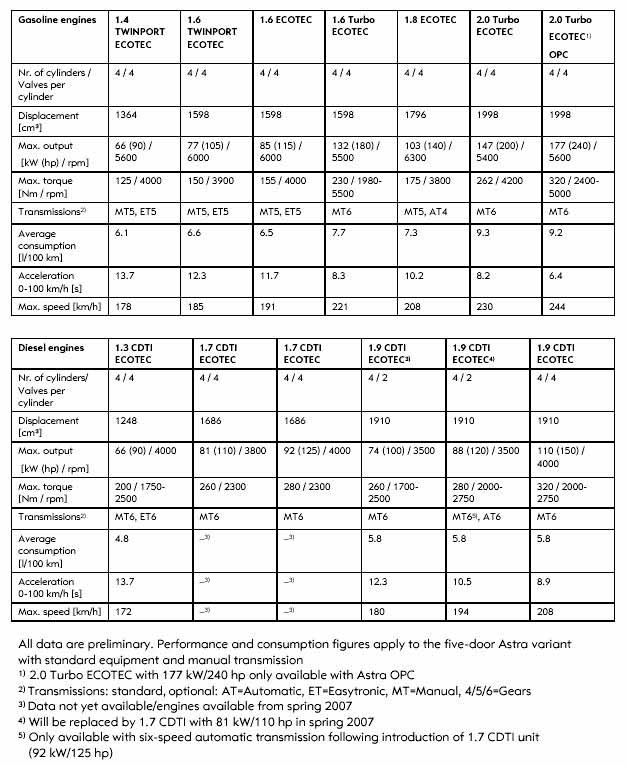
New look
Accentuated design for
stronger model and brand identity
The upcoming Astra sets itself apart from the competition with an even more
exciting, sporty look and sends a new signal in its segment. The design team
further honed the distinctive face that was presented with the third-generation
Astra in 2003 at the IAA and met with a positive response from customers
and automotive specialists alike. Thanks to the evolutionary concept, it
is still clearly recognizable as a member of the family, and designers were
also able to sharpen both model and brand identity. Integrated organic elements
such as the sharply drawn “eyebrows” above the imitation air intakes
serve as a blueprint for future Opel models. Above these crafted features,
the bumper is integrated into the Astra’s dynamic V-shaped front. The
dominant radiator mask also adds to the confident look. This impression is
enhanced in the five-door and station wagon models by the widened upper chrome
crossbar with integrated Opel logo. The distinctive decorative elements reduce
the gap to the hood, as well as taking the characteristic crease and continuing
it to the radiator grille vanes, which are also chrome-plated.
The headlamp housings in stylish chrome look also convey an additional sense
of quality. The Astra Sport, as well as the versions with xenon or curve
and cornering light are recognizable by their dark-tinted headlamp housings.
Other features of the new edition Astra include the front bumper with integrated
impact protection bars (five-door and station wagon models) as well as tail
lights in 3-D block design (five-door model), which already make the GTC’s
rear so eye-catching. The Astra station wagon features flowing, practical
roof rails in aluminum look. The Astra GTC now boasts a honeycomb grille
that highlights its sporty look even further.
New Equipment
Exclusivity and individuality
in series production
The panorama windshield is the best example of an Astra component which remains
unrivalled in this class. For the first time in a series production car,
the new edition of the Astra Cosmo GTC offers a field of view never seen
before. The around 1.8 square meter glass panel extends from the end of the
hood, over the front occupants’ heads to the middle of the roof. Unlike
contemporary glass roof designs, there is no crossbeam to obstruct the view,
enabling driver, front and rear passengers to enjoy an unrestricted view
similar to that in the cockpit of a sport airplane. This makes journeys a
special experience, be they across country or at night through a brightly-lit
city. The rigid panorama windshield is made from 5.5 mm-thick laminated safety
glass. Numerous crash simulations and real tests showed that the passive
safety is equal to that of the steel roof model, thanks to the GTC’s
strong A and B-pillars and an additional cross-member between the B-pillars.
The foil integrated in the panorama windshield prevents it from splintering
or penetrating into the passenger compartment in the event of an accident.
The same foil as in the lightly green-tinted panorama windshield, called
Solar Protect Glass, also plays the role of a warmth-absorbing layer. In
addition, a sophisticated shading system helps keep interior temperatures
regulated: the steplessly adjustable shade is easy to operate via a knob
in the ceiling. It disappears into the rear roof section when not in use.
In total, 11 patents were registered for this system.
Interiors in feel-good
quality
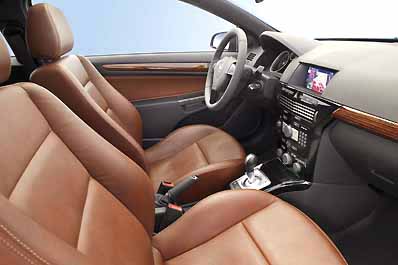 The new-edition Astra’s interior
boasts surfaces with an even more high-quality look for the center console,
additional chrome rings for the air conditioning and radio controls, as well
as new trim for the instrument panel and doors. The top Cosmo variant, for
example, is enhanced with luxurious piano lacquer surfaces and inlays on
the center console and steering wheel. Usually reserved for upper-class vehicles,
these applications create additional personalization options. With cashmere
beige upholstery designs, or saddle brown leather in the GTC, the Astra interior
can be completely customized in exclusive feel-good quality. The CD 30 MP3
infotainment system, the most popular choice among Astra customers, is available
from February with steering wheel remote controls and a stereo connection
for external audio equipment, such as an iPod. Other standard equipment
enhancements include the IDS sport chassis for the Astra Sport and Board
Info Display (BID) for the Astra Sport, Cosmo and OPC variants, new 16-inch
design wheels for the Edition equipment line, new 16-inch alloy wheels for
Astra Sport and Cosmo, as well as new wheel caps for the 16-inch steel wheels.
The Cosmo variant now also features fog lamps as standard. The new-edition Astra’s interior
boasts surfaces with an even more high-quality look for the center console,
additional chrome rings for the air conditioning and radio controls, as well
as new trim for the instrument panel and doors. The top Cosmo variant, for
example, is enhanced with luxurious piano lacquer surfaces and inlays on
the center console and steering wheel. Usually reserved for upper-class vehicles,
these applications create additional personalization options. With cashmere
beige upholstery designs, or saddle brown leather in the GTC, the Astra interior
can be completely customized in exclusive feel-good quality. The CD 30 MP3
infotainment system, the most popular choice among Astra customers, is available
from February with steering wheel remote controls and a stereo connection
for external audio equipment, such as an iPod. Other standard equipment
enhancements include the IDS sport chassis for the Astra Sport and Board
Info Display (BID) for the Astra Sport, Cosmo and OPC variants, new 16-inch
design wheels for the Edition equipment line, new 16-inch alloy wheels for
Astra Sport and Cosmo, as well as new wheel caps for the 16-inch steel wheels.
The Cosmo variant now also features fog lamps as standard. |
Step-by-step to dream
car
Astra customers who wish to configure their dream car down to the last detail
now have even more choice. The range of carefully selected Opel accessories
extends from fitted sun blinds for the rear window and rear side windows
to the mobile DVD player with seven-inch screen. The robust fiberglass roof
box with a volume of 480 liters and the Opel DUO ISOFIX child seat for children
weighing between nine and 18 kilograms are also easy to mount. The OPC line
package 1 is exclusively available with the Astra GTC and includes a front
and rear spoiler, side sills, rear apron and alloy wheels in various designs.
Five-star safety for maximum
passenger protection
When it comes to safety equipment the new-edition Astra is at the top level,
just like its predecessor. The consumer protection organization Euro NCAP
(European New Car Assessment Programme) rated the passive safety of the
new-edition Astra at the highest level - just like the predecessor model.
The Astra was awarded the top rating of five stars for passenger protection.
With a total of 34 points, Euro NCAP classified it as one of the safest sedans
in the compact class (small family cars). The Astra also achieved very good
results for child protection: the five-door model was awarded four stars
and 39 points. The Astra comes standard with the extensive SAFETEC safety
package, including shape-optimized thorax/pelvis side airbags in front. These
complement the two front airbags and the head curtain airbags that stretch
along the entire length of the interior in the left and right roof pillars.
Both outer rear seats come with ISOFIX mountings for child seats as standard.
New chassis
electronics
Top marks for agility,
safety and comfort
The new edition of the Astra offers driving performance with pronounced agility
and precise handling with a high level of driving safety. These qualities
helped the Astra win numerous comparison tests by the European specialist
press and in customer polls. The basis for this agility is the IDS (Interactive
Driving System) chassis with McPherson front axle and patented torsion-beam
rear axle. Every Astra comes standard with the Electronic Stability Program
ESPPlus, Traction Control TCPlus, front and rear disk brakes, Anti-lock Braking
System (ABS), Cornering Brake Control (CBC), Brake Assist and electro-hydraulic
power steering. An exceptional dimension of balance between driving comfort
and active safety is once again provided by the optional adaptive IDSPlus
chassis with electronic Continuous Damping Control (CDC). This integrated
chassis control system, in which the control units and sensors of ESPPlus,
ABS and CDC exchange data constantly, was introduced to the compact class
for the first time in the Opel Astra. Owners also benefit from IDSPlus when
it comes to driving fun: the sport mode is activated at the touch of a button,
resulting in more direct suspension, steering and gas pedal response, as
well as modified shift points in the automatic and Easytronic transmission
variants for greater sportiness.
Enhanced Trailer Stability
Assist prevents instability
The Opel Astra’s chassis is already among one of the best in its class,
but this was no reason for engineers to rest on their laurels. They found
potential for improvement in details such as the control system for the Trailer
Stability Assist (TSA). The newest generation of this safety system is available
for the first time in this class as an option in the Astra five-door, GTC
and station wagon models. Compared to the earlier generation of TSA, real-time
calculations are conducted more accurately and with greater sensitivity.
This helps reduce instability in car-trailer combinations earlier and more
effectively, as well as eliminating the risk of any abrupt emergency stopping
situations in normal driving conditions which might disrupt the traffic behind.
The cleverly devised system works together with the standard ESPPlus, recognizing
possible trailer yaw movements and actively counteracting them with regulated
braking. Be it swinging due to side wind, lane ruts, exaggerated maneuvering
or too high speed, the control electronics have an answer for every eventuality.
In the initial decisive reaction phase, TSA counters the swinging movements
by braking either the left or right front wheel. Should this measure be
insufficient, regulated braking is applied at all four wheels and engine
output reduced.
Pioneer in curve light
continues to lead the way
The Astra also leads the way when it comes to visibility and lighting. Opel
was the first automaker in this vehicle class to offer Adaptive Forward Lighting
(AFL), a steering-linked headlamp system with bi-xenon headlamps, dynamic
curve light function and adaptive highway light. The curve light turns the
headlamps into the curve depending on speed and steering angle, increasing
street illumination by up to 90 percent compared to fixed headlamps. At higher
speeds along a straight path, an automatic beam width regulator prevents
the light from blinding oncoming highway traffic, enabling the low beam lights
to project further ahead.
Information concerning specifications, equipment
and prices (recommended retail prices incl. VAT) applies to the models offered
in Germany. There may be differences in other markets. All data on fuel
consumption refers to combined fuel consumption of the base model in the
European test cycle. This data and driving performance values are preliminary.
Subject to alteration.
READER COMMENTS
Adam Opel AG, A member company
of the GM Group,
Ein Unternehmen der GM Gruppe,
 General Motors Corporation
General Motors Corporation
January 2007 |
BACK TO TOP |